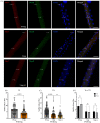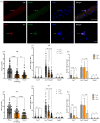Satellite Cells Exhibit Decreased Numbers and Impaired Functions on Single Myofibers Isolated from Vitamin B6-Deficient Mice
- PMID: 34960083
- PMCID: PMC8705767
- DOI: 10.3390/nu13124531
Satellite Cells Exhibit Decreased Numbers and Impaired Functions on Single Myofibers Isolated from Vitamin B6-Deficient Mice
Abstract
Emerging research in human studies suggests an association among vitamin B6, sarcopenia, and muscle strength. However, very little is known regarding its potential role at the cellular level, especially in muscle satellite cells. Therefore, to determine whether vitamin B6 affects the satellite cells, we isolated single myofibers from muscles of vitamin B6-deficient and vitamin B6-supplemented mice. Subsequently, we subjected them to single myofiber culture and observed the number and function of the satellite cells, which remained in their niche on the myofibers. Prior to culture, the vitamin B6-deficient myofibers exhibited a significantly lower number of quiescent satellite cells, as compared to that in the vitamin B6-supplemented myofibers, thereby suggesting that vitamin B6 deficiency induces a decline in the quiescent satellite cell pool in mouse muscles. After 48 and 72 h of culture, the number of proliferating satellite cells per cluster was similar between the vitamin B6-deficient and -supplemented myofibers, but their numbers decreased significantly after culturing the myofibers in vitamin B6-free medium. After 72 h of culture, the number of self-renewing satellite cells per cluster was significantly lower in the vitamin B6-deficient myofibers, and the vitamin B6-free medium further decreased this number. In conclusion, vitamin B6 deficiency appears to reduce the number of quiescent satellite cells and suppress the proliferation and self-renewal of satellite cells during myogenesis.
Keywords: amino acids; carnosine; proliferation; sarcopenia; satellite cells; self-renewal; single myofibers; skeletal muscle; vitamin B6.
Conflict of interest statement
The authors declare no conflict of interest. The funders had no role in the design of the study; in the collection, analyses, or interpretation of data; in the writing of the manuscript, or in the decision to publish the results.
Figures






Similar articles
-
Does Vitamin B6 Act as an Exercise Mimetic in Skeletal Muscle?Int J Mol Sci. 2024 Sep 15;25(18):9962. doi: 10.3390/ijms25189962. Int J Mol Sci. 2024. PMID: 39337450 Free PMC article. Review.
-
Isolation, Culture, and Immunostaining of Skeletal Muscle Myofibers from Wildtype and Nestin-GFP Mice as a Means to Analyze Satellite Cell.Methods Mol Biol. 2017;1556:51-102. doi: 10.1007/978-1-4939-6771-1_4. Methods Mol Biol. 2017. PMID: 28247345
-
Isolation and culture of skeletal muscle myofibers as a means to analyze satellite cells.Methods Mol Biol. 2013;946:431-68. doi: 10.1007/978-1-62703-128-8_28. Methods Mol Biol. 2013. PMID: 23179849 Free PMC article.
-
Isolation and culture of individual myofibers and their satellite cells from adult skeletal muscle.J Vis Exp. 2013 Mar 22;(73):e50074. doi: 10.3791/50074. J Vis Exp. 2013. PMID: 23542587 Free PMC article.
-
Defining the transcriptional signature of skeletal muscle stem cells.J Anim Sci. 2008 Apr;86(14 Suppl):E207-16. doi: 10.2527/jas.2007-0473. Epub 2007 Sep 18. J Anim Sci. 2008. PMID: 17878281 Free PMC article. Review.
Cited by
-
Relationship of Low Vitamin B6 Status with Sarcopenia, Frailty, and Mortality: A Narrative Review.Nutrients. 2024 Jan 4;16(1):177. doi: 10.3390/nu16010177. Nutrients. 2024. PMID: 38202006 Free PMC article. Review.
-
Effects of energy drinks on myogenic differentiation of murine C2C12 myoblasts.Sci Rep. 2023 May 25;13(1):8481. doi: 10.1038/s41598-023-35338-7. Sci Rep. 2023. PMID: 37231025 Free PMC article.
-
Comparison of Muscle, Bone and Fat Indices between Stages of Sarcopenia in Postmenopausal Malaysian Women.Malays J Med Sci. 2023 Oct;30(5):91-105. doi: 10.21315/mjms2023.30.5.8. Epub 2023 Oct 30. Malays J Med Sci. 2023. PMID: 37928789 Free PMC article.
-
Nutrition and Regulation of Muscle Protein Synthesis.Nutrients. 2023 Sep 16;15(18):4017. doi: 10.3390/nu15184017. Nutrients. 2023. PMID: 37764801 Free PMC article.
-
Does Vitamin B6 Act as an Exercise Mimetic in Skeletal Muscle?Int J Mol Sci. 2024 Sep 15;25(18):9962. doi: 10.3390/ijms25189962. Int J Mol Sci. 2024. PMID: 39337450 Free PMC article. Review.
References
MeSH terms
Substances
Grants and funding
LinkOut - more resources
Full Text Sources

